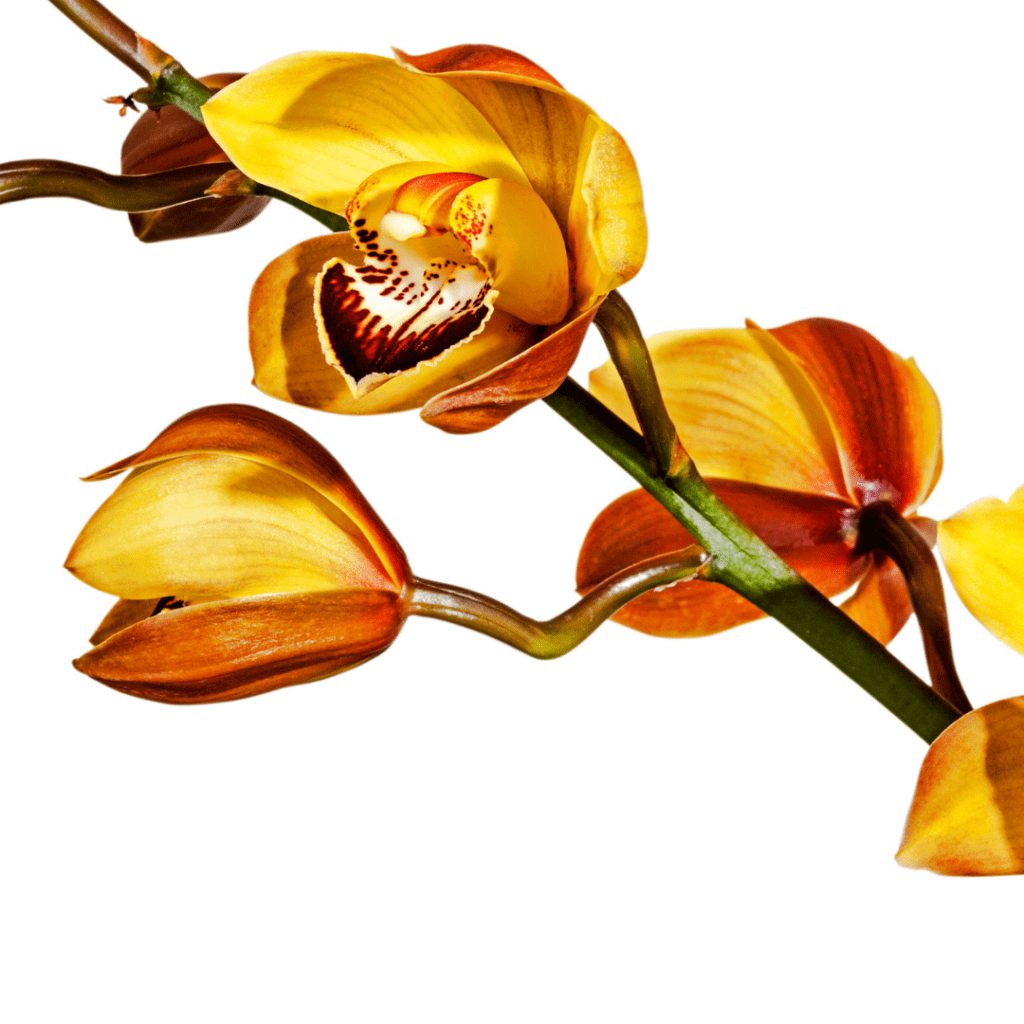It can be quite concerning to see your beloved plant showing signs of discoloration, and the fact that there are a number of reasons this could be happening likely doesn’t make you feel any better. Luckily, we have some of the most common reasons for yellow orchid stems listed below. Let’s get to the bottom of this so you can get your orchid back to being happy and healthy.
Reasons Why Orchid Stems Can Turn Yellow
There are so many possible reasons your orchid’s stem is turning yellow. Let’s take a look at each of the potential causes.
Stem Discoloration After Flowering
There is a natural aging process that is just simply a part of your Orchid’s life. Orchids, like any other living organism, go through life cycles. Once they have used their energy on producing beautiful blooms, the stem may start to turn yellow as it prepares for dormancy or enters a resting phase.
Usually, this won’t be an obvious discoloration, but sometimes it can become quite unsightly. As long as your plant doesn’t seem to be losing its vibrancy and the yellow area isn’t causing other issues for your plant, it should recover just fine with proper care during the dormancy stage.
Excessive Sunlight
Orchids need sufficient sunlight to thrive, but excessive exposure can lead to problems such as yellowing stems. Placing them in a spot where they receive intense rays all day long can cause a lot of harm to your plant. The leaves act as natural filters, and if they’re unable to shield the stem from excessive sun exposure, discoloration may occur.
To prevent this issue, consider moving your orchid away from windows or areas with intense sunlight during peak hours. Instead, opt for filtered or diffused light that mimics their natural habitat. Another option is using sheer curtains or blinds to create a gentle shade without completely blocking out the light. Avoid placing your orchid near heat sources like radiators or air conditioning units as these can amplify the effects of excessive sunlight.
Remember that each type of orchid has specific light preferences; some varieties require more direct sun than others. Researching the specific needs of your particular orchid will help you strike the right balance between adequate lighting and protection against overexposure.
To fix a yellowing stem due to excessive sunlight, you’ll want to move it as soon as possible, water it well if it hasn’t been watered in a while, and let the plant rest. Keeping it out of all direct sunlight for a few weeks should help it to recover. Keep in mind that the part of the stem that got too much sun may or may not go back to normal.
By providing optimal lighting conditions for your beloved flower friend, you’ll not only prevent yellowing stems but also promote healthy growth and vibrant blooms. So go ahead and give your precious orchids some well-deserved TLC by finding that perfect balance of light!
Overwatering Issues
Overwatering is a common mistake made by many orchid owners, and it can lead to yellowing stems. Less is more when watering your Orchid. Orchids do not like their roots sitting in soggy soil.
Overwatering
One of the first signs of overwatering is yellowing or wilting stems, so it’s pretty easy to catch this issue before it claims your plant’s vitality. When you water your orchid too frequently or use excessive amounts of water, the roots become suffocated and unable to absorb nutrients properly. This can result in nutrient deficiencies, root rot, and will cause the stem to turn yellow.
To avoid overwatering your orchids, make sure you are using well-draining potting mix specifically designed for orchids. Allow the top inch of the potting mix to dry out before watering again. It’s better to underwater than overwater an orchid.
If you suspect that your orchid has been overwatered, take immediate action by adjusting your watering routine. Allow the plant to dry out completely between waterings and consider repotting into fresh potting mix if the current mix is holding on to too much moisture for too long. Remember that each type of orchid may have slightly different watering needs, so always consult specific care instructions for your particular species.
Problems With Fertilizing
Nutrient deficiencies and overfertilizing can both lead to yellowing orchid stems. Let’s take a closer look at each of these problems.
Nutrient Deficiencies
As many Orchid owners know, Orchids are fairly sensitive to a lack of available nutrients. They require specific nutrients in precise amounts to thrive. If your orchid is lacking essential nutrients like nitrogen, phosphorus, or potassium, its stems may start turning yellow. This can be caused by using the wrong type of fertilizer or not providing enough nutrients for your plant.
To fix a nutrient deficiency, begin by using an Orchid-specific plant food that you can apply with each watering. This will give your plant a smaller amount of nutrients in more frequent intervals, giving your Orchid a better chance at absorbing and using those nutrients effectively.
Over Fertilizing
On the other hand, over fertilizing can also have detrimental effects on your orchid’s stem color. Too much fertilizer can cause salt buildup in the soil, which hinders proper nutrient absorption and leads to fertilizer burn. The first sign of fertilizer burn is typically yellowing stems. It’s important to follow the recommended fertilization schedule for your specific type of orchid and avoid applying excessive amounts of fertilizer.
To fix over fertilizing, you’ll want to flush out all of the built up salts in the potting media. Run the soil under room-temperature water for several minutes, and then let all excess water drain. Do not fertilize your plant again for several weeks. When it is time to fertilize again, use an Orchid-specific plant food at half strength for a month before moving up to full-strength.
By addressing these problems with fertilizing promptly and providing your orchids with proper nutrition, you can help prevent their stems from turning yellow and promote healthy growth overall.
Temperature Fluctuations
Sudden changes in temperature can cause stress to your Orchid, leading to yellowing of the stems. Orchids prefer a stable and consistent environment, so extreme fluctuations can disrupt their growth.
During the day, orchids prefer temperatures between 70-85 degrees Fahrenheit, and at night, they like slightly cooler temperatures between 60-70 degrees Fahrenheit. If your orchid experiences drastic shifts in temperature beyond these ranges, it may result in yellowing of the stem.
Even if the environment is relatively stable, think about things like temperature fluctuation from placing your orchid near drafty windows or vents. Cold drafts during winter months or hot gusts from air conditioning systems can shock your orchid and damage its stem.
To prevent this issue, ensure that your orchid is placed away from direct sources of heat or cold air. Keep it in an area with a relatively stable climate and avoid exposing it to sudden changes in temperature. Keeping a thermometer near your plant can really help you figure out if this is the cause behind your Orchid’s yellowing stem.
If this is the reason your plant’s stem is turning yellow, fix the environment as soon as you can, and your plant should rebound rather quickly. By maintaining a consistent environment for your orchid, you can help prevent yellowing of the stem in the future.
Pests and Diseases
Pests and diseases can wreak havoc on your precious orchids, causing their stems to turn yellow. Many houseplant owners will tell you that there are simply too many pests that may infest your beloved Orchid, and there are diseases and infections that can take your plant’s health just as quickly as pests can. When it comes to pests and diseases, it’s easier to prevent an infestation than it might be to treat it.
Some possible pests that may cause your Orchid’s stem to yellow are aphids, scale, and spider mites. Each of these pests can be controlled by wiping down the whole plant with soapy water. If your plant has fungus gnats, you’ll want to set sticky traps out to trap them and treat the soil with a solution of 1 part hydrogen peroxide to 3 parts water. This will instantly kill any eggs they have laid in the soil. Repeat all of these processes weekly until your plant is pest free!
Fungal Infections
One type of fungal infection that often affects orchids is root rot. This occurs when the roots become waterlogged or are exposed to excessive moisture for prolonged periods. The fungus attacks the roots, preventing them from properly absorbing nutrients and water, leading to yellowing stems.
Another fungal disease that can cause yellowing stems is powdery mildew. This fuzzy white or gray powder-like substance typically appears on the leaves but can also spread to the stems. It weakens the plant’s overall health, resulting in discolored and weakened stems.
To prevent fungal infections, it’s crucial to maintain proper airflow around your orchid plants and avoid overwatering them and ensure the pot has drainage holes so excess water can escape easily.
If you suspect a fungal infection, promptly remove any affected parts using sterilized tools to prevent further spread of the disease, and apply an appropriate fungicide recommended for orchids as directed by the product label.
Orchid Stem Turning Yellow And Flowers Falling Off
Any of the reasons above may even cause your plant’s flowers to fall off before they are done blooming. If the plant is overly stressed, it will stop putting effort into the bloom and allow it to discolor and eventually fall off. Now, a flower may also fall off before it’s gone its whole bloom cycle if the plant does not have enough nutrients to sustain it. This would cause the plant to yellow over time, and the flower to fall off soon after.
Yellow Orchid Stems After Cutting
After cutting an orchid stem, it is not uncommon for it to turn yellow. This can be a normal part of the plant’s growth cycle or it could indicate a problem.
Sometimes, it’s as simple as the plant redirecting its resources. When you remove a stem, the orchid may shift its energy towards new growth, causing the remaining stems to lose their green color and turn yellow.
It could also be due to improper care post-cutting. If you don’t provide your orchid with proper conditions such as adequate light, temperature, and humidity levels after pruning, the stems may become stressed and start turning yellow.
Removing Yellow Stems
When you notice that your orchid stem has turned yellow, it’s important to take action to prevent further damage and promote the health of your plant. Removing the yellow stems is often an important step in this process.
To remove a yellow stem, use a clean and sharp pair of sterilized pruning shears or scissors to cut the yellow stem as close as possible to where it connects with the main stalk or base of the plant. This will help prevent any decay from spreading further into the orchid. If the yellow is on the main stem, it’s typically best to leave it unless it is actually harming the rest of your plant.
After removing the yellow stems, monitor your orchid closely for any signs of new growth or regrowth. Provide optimal care by ensuring proper sunlight, watering habits, fertilization, temperature control, and pest prevention measures.
More Orchid Resources
To learn more about how to care for your orchid, check out our other recent articles or visit our online shop to stock up on supplies to ensure your orchid-growing success.



